Your cart is currently empty!
What Is The Difference Between Slip and Underglaze?
Published:
Last Updated:
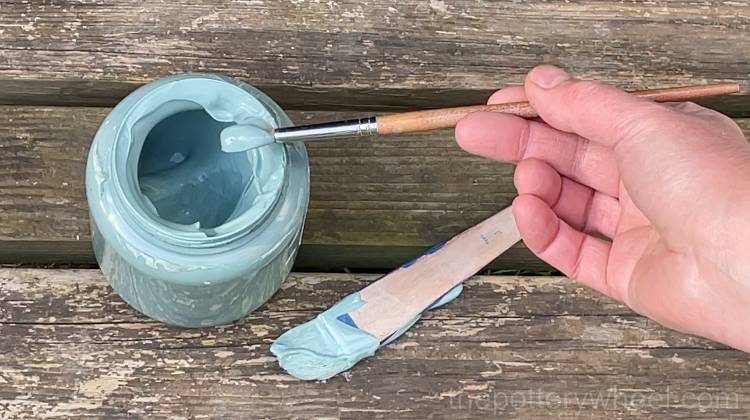
Affiliate Disclaimer
As an affiliate, we may earn a commission from qualifying purchases. We get commissions for purchases made through links on this website from Amazon and other third parties.
Slip and underglaze are just two of the many ways you can decorate pottery. But, what is the difference between slip and underglaze? And which one should you use on your pottery?
Slip and underglaze are both made of a mixture of clay and water. However, slip contains more clay and can add texture to pottery. Underglaze contains some glass-forming ingredients and behaves a more like glaze. Also, while underglaze tends to keep its color when it’s fired, slip can look quite different after firing.
The Difference Between Slip and Underglaze
Despite these differences, slip, and underglaze can be used together and can complement each other nicely. Let’s look closer at the differences before looking at how they work together.
Features of Underglaze:
- The main purpose of underglaze is to decorate pottery. It is usually covered with a clear glaze after application. The clear glaze seals and protects the pottery and its decoration.
- Underglaze can be applied to pottery in many ways. You take a look at these different underglaze techniques in this guide to using underglaze.
- Underglazes are often commercially produced and can be mixed together like paint to form other colors.
- It’s possible to create your own unique colors using specific underglaze recipes.
- It can be applied to greenware pottery at any point, or to bisque-fired pots. However, it is easiest to apply to leather hard or bisqueware.
- Underglaze is normally matte before it has been glazed. However, some brands of underglaze can have a slightly shiny satin sheen once fired.
- Usually, underglaze is not used for adding texture effects because it is smooth and quite runny.
- Underglaze normally stays the same color after it has been fired in a kiln. However, underglaze colors will often brighten and intensify when clear-glazed.
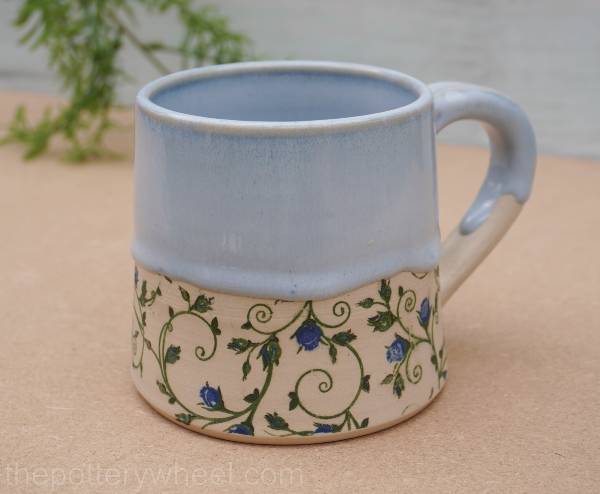
If you like the look of this mug, you can check out my pottery store here.
Features of Slip:
- Slip is a liquid form of clay, and is made from a mixture of clay and water.
- It can be used to join pieces of clay, mend cracks, and also to decorate pottery.
- Decorating slip contains ceramic stains that give it color.
- You can buy readymade decorating slips, but you can also make them easily by adding a colored stain to liquid clay. You can read more about making colored slip here.
- It’s usually best to use clay slip on leather hard clay that contains some moisture. Applying slip to dry greenware can work sometimes, but it often flakes off.
- Unlike underglaze, slip can’t be used on bisqueware pottery. Because it has a high clay content, slip shrinks and peels off bisqueware as it dries.
- Clip can be mixed to different consistencies, either thinner or thicker. Thicker slips can be used to add texture to pottery. An example of this is slip trailing.
- When slip is fired it sometimes changes color from the unfired state.
- Similar to underglaze, if you don’t apply a coat of clear glaze to decorating slip, it will have a matte finish.
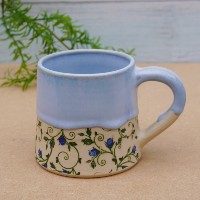
Visit The Pottery Wheel Store
Looking for home made pottery? Fancy Treating yourself, or want to buy a unique gift? Check out my handmade pottery store here…
How are Slip and Underglaze Used?
Although they share some similarities, slip, and underglaze can be used in different ways. Here are some of the ways that you can use clay slip…
Clay Slip and Its Uses
While underglaze is used purely for decoration, clay slip has many practical uses too. Here are some of the ways that slip is essential for making pottery.
1) On The Pottery Wheel
Clay slip is essential for working on the potter’s wheel. The wet clay mixture that forms on your hands and the pottery as it moves beneath your hands is clay slip.
It is this slippery clay mixture that allows you to shape the clay and stops the pottery from snagging on your hands as it turns.
2) Joining Clay
Slip is used in pottery as a kind of glue. If you need to join two or more pieces of clay together, you can use slip to bond them securely.
The most effective way to attach clay is to use the slip-and-score method. This involves scoring into the two surfaces that are going to be attached.
You can score into the clay with a clay scoring tool or a regular kitchen fork. Then apply some clay slip to the scored area. Press the two surfaces together. The two rough surfaces covered in slip will mingle together and form a secure bond. You can read more about how to use slip and score here.
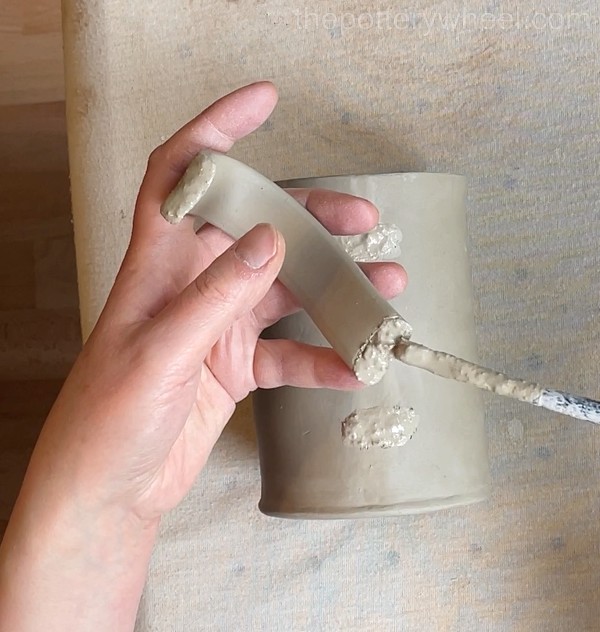
3) Slip for Decoration
Clay slip can be used to decorate pottery in several ways. Decorating slip has a smooth, lump-free texture, and contains colored ceramic stains. It can be applied to greenware pottery in many ways, including painting, sponging, and spraying.
Some other techniques include:
Slip Trailing
Another technique is called slip trailing. This involves filling a rubber slip trailing bulb the size of your hand with slip. When the rubber bulb is squeezed, the slip is dispensed onto your pottery through a narrow nozzle on the bulb. The slip is then trailed onto the pottery in a pattern.
Marbling With Slip
Different colored slips can be poured over pottery to create a drippy effect. Or they can be poured onto a piece of pottery like a plate and gently turned around to create a marbling effect with the different colors.
Free Hand Patterns
You can use an object like a comb or your fingers and drag them through the slip to make patterns on your pottery with dynamism and movement.
4) Mending With Slip
Greenware pottery is fragile and can break easily. Also, as pottery dries cracks can form. Sometimes it’s worth trying to rescue damaged or cracked pottery before it’s fired. It is possible to mend some cracks in your pottery using slip.
You can easily make a reinforced slip that can be used to fix cracks and damage to greenware. If you want to know more about how to make and use a strong mending slip you can take a look at my guide here.
5) Slip Casting
Another important way that slip can be used in pottery, is in the process of slip casting. This is when casting slip is used in a plaster mold to form pottery. The slip is poured into the mold and allowed to rest for a few moments. Excess slip is tipped out of the mold back into the slip bucket.
A skin of slip is left behind on the mold, which dries and shrinks away from the plaster. Once it’s dry, the clay, which is now firm, can be removed from the mold. Multi-part molds are used to make parts of a piece of pottery that can be joined together to form one larger piece of pottery.
How is Underglaze Used?
One main difference between slip and underglaze is that underglaze is used exclusively for decorative purposes.
Underglaze is usually used on bisque pottery or leather hard clay. If it is used on bisqueware, the clear glaze is applied to the pottery after the underglaze has dried.
By contrast, if underglaze is applied to greenware, the pottery is then bisque-fired. Clear glaze is then applied to the underglaze once it’s been bisqued.
Underglaze can be applied to pottery using a wide range of techniques. Some of the most popular techniques include:
- Painting
- Dipping
- Spraying
- Sponging
- Transfers and decals
- Underglaze pencils
- Underglaze pens
- Stencils
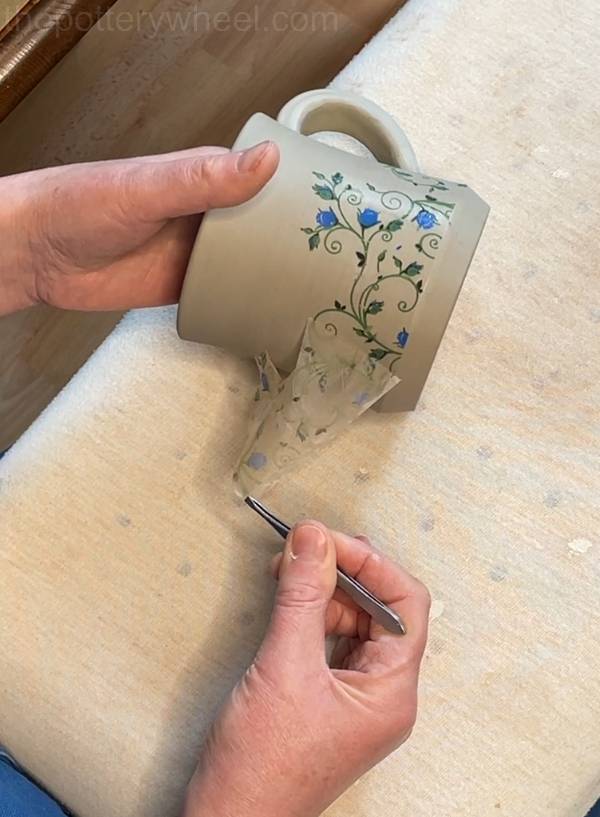
If you want to know more underglaze techniques, you can check out my guide to using underglaze here.
A key difference between slip and underglaze is that using underglaze feels a bit more like using paint. Underglaze is usually thinner than slip and paints onto pottery more like an acrylic or watercolor. By contrast, decorating slip is thicker, and it feels like you are painting with clay.
Can Slip and Underglaze Be Used Together?
Yes, slip and underglaze can be used on the same piece of pottery. In fact, they can complement each other well.
For example, slip can be used to create a raised texture on the pottery. This is then allowed to dry and harden. Underglaze can then be applied on top of the textured slip.
When the underglaze is dry, the surface of the texture can be sanded off. This allows the color of the clay body or the colored slip to peep through the underglaze.
Important: It’s essential to wear a respirator mask when sanding dry clay. Sanding clay creates fine clay dust in the air, which is bad for your lungs. You can read about how to sand clay here.
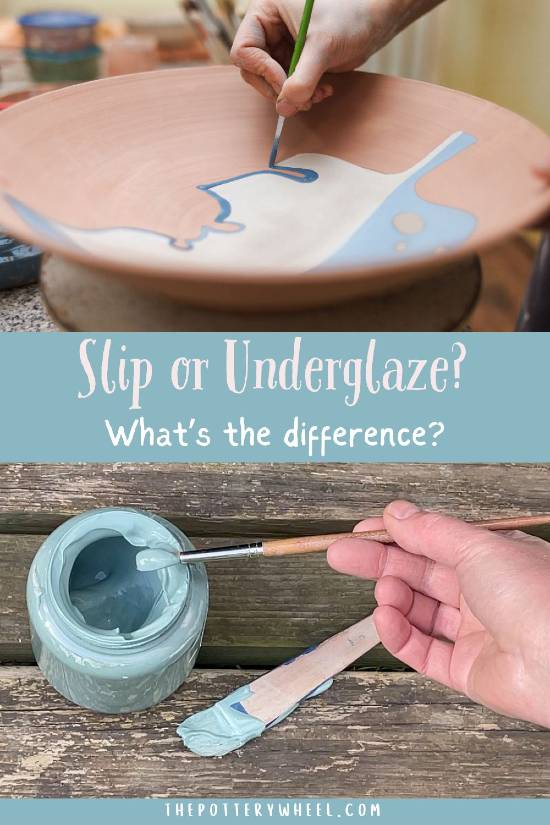
Final Thoughts
I sometimes think of underglaze as being a special kind of slip. Like slip, underglaze is liquid clay. However, it contains additives that enable it to work a little differently from slip.
The main similarity between underglaze and slip is that they are both used for decorating pottery. The key difference between underglaze and slip is that underglaze is purely decorative. By contrast, slip is a multipurpose pottery allrounder without which making most pottery would be impossible.



